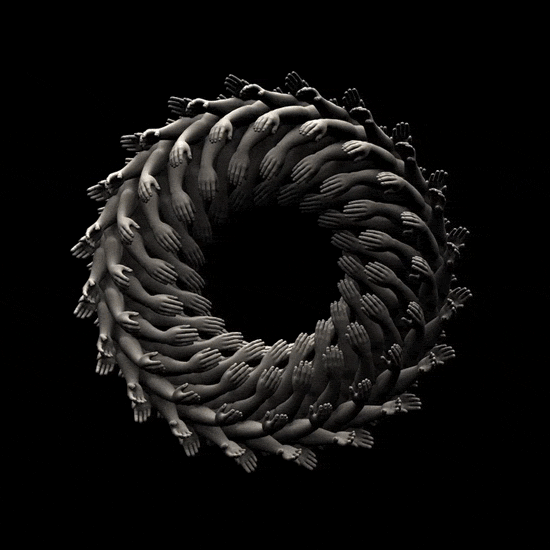 |
| The Creation of Adam (detail), 1511-12, Michelangelo (before restoration). |
 |
| Praying Hands, 1508, Albrecht Durer |
One of the easiest means of separating the work of a self-taught or amateur artist from that of one professionally trained is to look at their expertise in drawing or painting hands. Of course, if the artist does not displayed such efforts, that likewise tells you a lot about his or her skills. Second only to the face, hands may well be the most difficult art content an artist can attempt to render. Moreover, the standards are high. We see our own hands and those of others hundreds of times a day. Thus, virtually everyone is an expert on what hands should look like when drawn or painted. That being the case, even the most casual observer can spot errors of simple ineptitude in ten seconds from ten feet. In having taught hundreds of artists how to draw hands, the one mistake most often made is concentrating on the fingers rather than the hand itself. I always advised students to first draw the hand as if it were wearing a mitten. Once that is seen as an anatomically correct approximation, then, and only then, should they begin dividing up the "mitten" into details like fingers, nails, thumb, palm, knuckles, etc. That, I've found, to be a good "rule of thumb."
 |
| Mona Lisa (detail), 1508, Leonardo da Vinci |
Artists have long found hands to be quite expressive. It's highly debatable as to which artists has painted the most famous hands in the history of painted hands. Some might suggest that Michelangelo's hands of Adam and God from the Sistine Chapel Ceiling (top) are the most famous. Others might afford that distinction to those of the German artist, Albrecht Durer, and his Praying Hands (above, right), even those who don't know who created them. Still others might afford that distinction to the hands of Leonardo's Mona Lisa (above). If you'd like others to pick from, see how many of those shown below you can identify as to painter and painting.
 |
With the exception of the two (restored) images by Michelangelo, don't
feel bad if you can't put your "finger" on the artists' names, they are not easy. |
 |
| Handprints, 1982, Andy Warhol |
Whether you've ever come to think about it, or not, painting hands were one of the very first content areas tackled by the very first artist as they painted on the stone walls of their underground homes and communal gathering places. Hand print paintings such as those below have been dated as early as 40,800 years ago to as "recently" as 11,000 to 14,000 years ago. It's interesting to study the similarities and differences arising after so many thousands of years by observing Andy Warhol's 1982
Handprints (left)
.
 |
Experts disagree as to exactly how these painted handprints were made.
Some have suggested a daubing technique with a large, furry, dead animal,
while others suggest the paint was "blown" on though a hollow reed. |
 |
Study Sheet with Seven Hands,
1885, Vincent van Gogh |
Quite apart from Warhol, Michelangelo, Leonardo, and Durer, there have been some very famous artist who have studied the human hand as a means of improving the skill in drawing it, as seen in Vincent van Gogh's
Study Sheet with Seven Hands (right) dating from 1885. Notice that some of them are far from perfect. The
Drawing Hands of M.C. Escher created in 1948 have always fascinated me. As for my own efforts in painting hands, during the 1970s, I did a series of fourteen larger than life hands in various configurations, holding objects or engage in some activity. The final painting in the "Hands of Love" series I titled
The Hands of Love XIV (below, left). Inasmuch as I've always worked from photos, I've never found hands to be particularly difficult. Nonetheless, I have long recommended drawing them from life as an excellent exercise in the development of accurate hand-eye coordination. The best part is, you always have your model "handy."
 |
| Drawing Hands, 1948, M.C. Escher |
 |
Copyright, Jim Lane
The Hands of Love XIV, 1978, Jim Lane
|
For those who have found drawing or painting hands to be a challenge, I should point out that a greater challenge by far is that of
sculpting hands. Even working in wax for casting in bronze is no easy task. But at least wax (or clay) is a relatively "forgiving" three-dimensional medium. Imagine the skills to be mastered by the likes of Michelangelo, Bernini, or Rodin (below) in carving them from
marble. More recent artists, applying their skills using digital software, have created what I consider even more amazing works than those seen above. I wish I could give credit where it's due, but very often such artists seem to enjoy posting their work anonymously, or at least after a few months of posts and reposts, they soon become anonymous. The two images at the bottom, one attempting to "out-Escher" Escher, the other an iris of ever-moving hands are nothing less than mindboggling.
 |
| Two-thousand years of sculpted hands. All but Rodin's are in marble. |
 |
| Artist's Hands Painting. |

Source: rene.centerblog.net












No comments:
Post a Comment